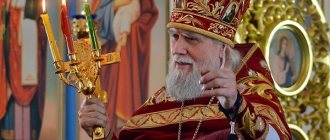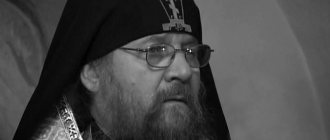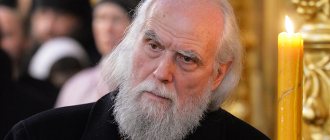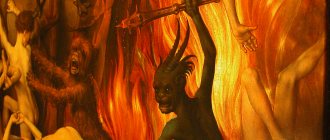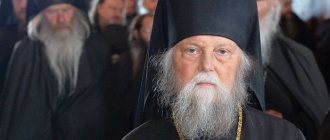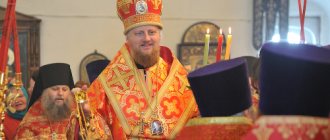The reprimand of Father Herman, who received permission to hold a special prayer service from the ruling bishop, will help cleanse the believer’s soul and free himself from the destructive demonic influence. To read incantatory prayers requires special spiritual strength and power, therefore not all priests are allowed to perform such services.
The miraculous power of the rite of reprimand has been known since ancient times. The Gospel tells of demoniacs cured by the Savior. Those possessed by an unclean spirit cannot get rid of the evil one on their own; they need outside help. The sufferer receives prayer support during the rite of reprimand.
How Father German reprimands in Sergiev Posad - reviews from believers
The church rite of exorcism from the possessed is performed not far from Moscow on the territory of the monastery of the Holy Trinity St. Sergius Lavra. Archimandrite German (Chesnokov) carries out a mass lecture according to the most ancient canons.
Believers who attended the service talk about the strong impression they received from the ceremony. The feeling of belonging to the divine arises upon entering the gate temple and intensifies during the speech of the clergyman.
The reprimand is preceded by Father Herman's sermon, guiding the believers and penetrating deep into the soul. This is followed by an unusually long special prayer, accompanied by the unnatural muttering and howling of the possessed.
Ordinary people watch with fear how the unclean spirit manifests itself in those possessed by demons. Sprinkling with holy water causes disgusting convulsions in the possessed, animal sounds burst out of their mouths, and people take on terrible forms.
After visiting the lecture three times, believers notice noticeable changes in their daily lives. For some, the ceremony helped in their personal lives; for others, their loved ones were cured of addictions and became kinder and calmer.
From the following article you will learn about the life and work of Hieromonk Photius.
Why they were called the main exorcist of the country
Father Herman gained fame not only for his rituals of exorcism, but also for his wise sayings. The entire Orthodox world knows how he exorcised evil spirits from parishioners.
Exorcism is also called reprimand. Father Herman was called the main exorcist of the country. But as far as we know, he was the only monk in Russia who was allowed by the Russian Orthodox Church to conduct such sessions.
With the blessing of Patriarch Alexy II, the exorcism ceremony was recorded on video. At the same time, members of the special commission testified that the procedure had a positive effect on the possessed.
The reporting process itself was carried out free of charge. However, there were voluntary donations, and they were used for temple needs. The archimandrite gave all his strength to help those suffering who were possessed. The biography of Father German from Sergiev Posad claims that he lived his entire spiritual life struggling with someone else's obsession.
Biography of Father German Chesnokov
Archimandrite German, in the world Alexander, (Chesnokov) was born on August 30, 1941. His entire life is devoted to boundless service to God and activities in the fight against unclean spirits. He strives to introduce the faith and cleanse the souls of the Orthodox from demonic influence.
The biography of Alexander Chesnokov includes military service, admission to the Moscow Automobile and Road Institute, and gradual unity with God. After graduating from the theological academy, Father German becomes a novice of the Lavra, and then a monk of the Trinity-Sergius Monastery.
Death of Archimandrite Herman from coronavirus
Official representatives of the Trinity-Sergius Lavra testified that Abbot German passed away on August 8, 2020. He was 79 years old and the official cause of death was complications caused by coronavirus infection. Since the spring, the clergyman had been fighting this disease, but lost.
An outbreak of the epidemic occurred in the monastery in mid-spring, shortly before Easter. However, clergy and parishioners defended Easter services, despite the ban on holding mass events.
Father Herman fell ill, presumably in April. But by May his condition worsened. He was even connected to a ventilator. Doctors fought for his life, but they could not cure him.
The brothers in the monastery greatly mourn the death of Father Herman and ask parishioners to offer prayers for the repose of this holy man.
Schedule of lectures in Sergiev Posad
You can attend the lecture of Archimandrite Herman by visiting the Holy Trinity Monastery of Sergiev Posad. The rite of reprimanding the possessed is not carried out on the twelfth holidays, the most important holidays in Orthodoxy.
The location of the ceremony every Friday, Saturday and Sunday is the Church of the Holy Apostles Peter and Paul. The rite of exorcism of unclean spirits begins at 12:00.
Reception hours can be confirmed by phone.
Hierodeacon German (Ryabtsev). A life dedicated to God.
Father German (Ryabtsev). Photo by Maxim Shtykov Today Hierodeacon German (Ryabtsev) turned 60 years old.
He himself regards these figures with irony and believes that at sixty, life is just beginning. Let it be! In his younger years, he performed on the professional music stage with Vladimir Kuzmin, Yuri Antonov and other famous musicians. Then there was a period of solo creativity, and a little later he came to the Valaam Monastery, where he was appointed director of the fraternal choir. Over time, the monastery began to publish audio recordings of this choir, and they could be purchased in church shops. For me, as for many people, my acquaintance with the work of Father Herman began at the time when the first album of the choir of the brethren of the Valaam Monastery was released. From this moment in the biography we begin a conversation with Father Herman.
— The main idea of recording the albums was to convey every word of prayer. For me, ” says Hierodeacon Herman, “
these are not just chants. First of all, this is prayer. As far as I remember, it was impossible to make out a single word in the chants that were recorded in churches. It sounded simply beautiful singing, but it was unclear what they were singing about.
Therefore, I immediately suggested to Father Hegumen (Bishop Pankraty (Zherdev), at that time an archimandrite - M.Sh.)
make our recordings in the studio using good equipment.
So that each person has a separate microphone so that the spoken words are perfectly audible. When I was accused that our works had too artificial a sound, I replied that I didn’t even have the task of imitating church sound. The task was to make an album of such sound quality that would fully meet the requirements of modern equipment. Otherwise, there is no point in doing work that no one will listen to because the sound is bad. — Father, tell us how the recording of the first album took place.
“Everything went like clockwork for us because there was a blessing!”
In 1993, I began recording services on cassette “point-and-shoot” cameras, like a voice recorder. Father Pankraty noticed, he liked these recordings, and he was inspired by the idea of publishing our chants. Then I tell him: “I’m a former professional musician, I still have friends in Moscow who could help.” These are musicians from “Araks”: Vadim Golutvin, Seryozha Rudnitsky, sound engineers Valera Andreev and Volodya Cherepanov...
Father Abbot blessed us right away, and so it began!
I went to the studio of the Lenkom Theater and met with the guys. Then they went to Mark Zakharov (chief director of the Lenkom Theater - M.Sh.)
, discussed my request and everything worked out. We recorded the album in a month. Each singer sang into a separate microphone. And there was one more feature. I record almost everything as a double track or overdub. That is, having recorded one track, I turn it on for playback, and the second for recording and record it synchronously with the first. Then, with the finished material, I came to the St. Petersburg courtyard of the Valaam Monastery to visit Father Igumen. Getting in. And he has guests from the Orthodox Church in America - Priest Vasily and the future Primate of the OCA, Metropolitan Jonah.
I turned on the album on Father Igumen's music center. Father's face changed - he didn't expect it to be so powerful! Eason with an octave, all this with a professional sound... And the shocked Americans say: “This needs to be published in America!”
And indeed from afar, even earlier than in Russia. After Easter 1994, I went to California to launch this album. There it was released under the title “Chants from Valaam”.
Then in 1996 we recorded the English album “Taste The Fountain Of Immortality”. We worked in the Moscow studio of the GDRZ. This recording took place thanks to Nikita Mikhalkov - he fully paid for our studio rent. This is active piety! This album is still sold in America.
— Father Herman, when did you start playing?
- What does “play” mean?
I always played. But actually, my debut on the professional stage took place at the age of 13. My older brother's friends took me to sing and play guitar at a dance in the park. I even received some money - about twenty rubles. - What did you perform?
— English-language songs.
“Beatles”, “Doors”, “Creedence”... (laughs - M.Sh.). — At what point did you realize that you were already a believer?
Was there some kind of shock or sign, figuratively speaking? - No, everything happened quietly and imperceptibly. Thanks to Volodya Kuzmin, I went to church for the first time, and thanks to his wife Tatyana Artemyeva, I received communion for the first time. The first communion was in Gagra...
At that time I worked in a Sochi restaurant with Masha Rasputina. And Tatyana (Volodya Kuzmin’s wife) persuaded me to go to church to receive communion. I went to Gagra, there was an amazing priest there, from the Caucasian hermits. I confessed to him and took communion for the first time in my life.
He came to Moscow already as a church man. I started going to services... Mainly at the Trifonovsky Church, which is near the Rizhsky station. And then he began to go to the Church of the Resurrection of the Word in Bryusov Lane (formerly Nezhdanova Street), where Anatoly Grindenko’s choir sang. This was around 1989. —
Tell us about life in England.
You had a performance there, right? - Yes it was. The first time I came for a month, performed at a club with my songs. The next month a very good article was published in the famous English music magazine Melody Maker.
Later I came for six months just to see if I would survive there. Then I realized that there is no point in living in a foreign land, because you will never belong there. The immigrant society there did not impress me, and I realized that you can only live a normal, full life where you were born. —
Father Herman, how did you end up on Valaam?
— On December 3, 1991, I came to Archimandrite Kirill (Pavlov) at the Trinity-Sergius Lavra. At that time I lived in a certain place, in an Orthodox community, and I no longer had the strength to live there. “Bless me,” I say, “to leave from there.” “I bless you,” answered Father Kirill. -Where to? - To the monastery. - Fine. Then tell me which one. - You sing and read, right? Let's go to Valaam! The monastery there is currently being restored and singers are needed. And I will write a letter to the Abbot to receive you. - Save me, God! Bless me, father,” I replied. In the evening of this day we went to Optina Pustyn for the patronal feast - the Entry of the Most Holy Theotokos into the temple.
And the next evening I returned to Moscow, boarded the Moscow-St. Petersburg train, and on the fifth I was already at the courtyard of the Valaam Monastery. He lived on the farmstead for nine months, and in September 1992 he moved to the island itself. Just on the day of the Beheading of John the Baptist.
Photo by Hieromonk Savvaty (Sevastyanov)
- Have you already had an idea about the Znamenny chant?
- A little. Exclusively listening to the choir of Anatoly Grindenko. I once went to the Odessa Monastery, and they were just giving a concert in Odessa. There were admirers of A. Grindenko’s work there, and I heard recordings of the choir from these guys. I was so impressed that I decided to study and preach this wonderful chant.
— Do you have favorite places on Valaam?
“I’m generally a terrible homebody.” I lived on the island for five years and had no idea where, for example, Avraamievsky Skete or “Second Point” was located...
The first years were generally very difficult - every day in the choir, without days off.
Services in full, ancient rite. If the vigil, then it began at one in the morning and ended at ten in the morning (midnight office, matins, hours, liturgy). Polyeleos were often served. And at the same time I was studying at the seminary... It used to be that you came to your cell and made a choice - either light the stove or fall asleep. You won’t be able to do both. —
Where did you live at that moment?
— In the inner square of the monastery.
Then I was sent to the monastery of John the Baptist (in Valaam they say not “to the monastery”, but “to the monastery.” Apparently this is due to the fact that most of the monasteries are located on separate islands.
– editor’s note)
. On the day of the Beheading of his head, September 11. Lived on this island from 1994 to 1996.
At first there was no monastery there at all. Some kind of cardboard house was thrown to us from a helicopter, and we insulated it as best we could. The “potbelly stove” was lined with bricks... Three times a night we had to get up and heat it. So we lived with one brother, Viktor Kovach, now he is Hieroschemamonk Seraphim.
My successor at tonsure was Father Raphael (Berestov; resident of the Valaam Monastery in 1993–2000 - editor's note.
).
He then blessed me with a chainsaw, and I felled the forest (smiles - M.Sh.) .
On weekdays, Victor and I asceticised at Predtechenskoe, and on Saturday evening we went to a vigil at the All Saints Skete, where Father Raphael lived.
I had a four-channel porta studio (like a “soap box”). There was a battery-powered condenser instrumental microphone. And the porta studio had a 12 volt adapter. I found the wire, connected it to the car battery and - great! Two months was enough.
It was there that I prepared drafts of the albums “Northern Athos”, “Blessed Saturday”, adapted Znamenny and other ancient chants into English for the album “Taste The Fountain Of Immortality”... All this was done on Predtechensky Island. There was no electricity, but there was a battery-powered studio! (laughs - M.Sh.)
Everything was recorded on regular full-width tape cassettes. The usual speed is four and a half, but here the ninth is twice as fast, and four tracks are written in one direction at once.
And in general, at this porta studio I made a lot of works - “Monastic Rule”, “Blessed Saturday”, “Lenten Triodion”, “Holy Week and Colored Triodion”... After recording the first album of the fraternal choir “Behold the Bridegroom Cometh”, work followed on the Easter album “Resurrection Day” and “Northern Athos”.
These recordings were widely distributed throughout the country and many people learned about the Valaam Monastery from those who had not yet heard of it. We continue our conversation with Father Herman.
— Until now, your calling card is the chant “Agni Parfene”, published on the album “Northern Athos”.
How did you work on the Russian-language text? — It was in America that the future Metropolitan Jonah gave me the English text of this chant, and I translated it from it.
When I made this translation, I didn’t allow myself any “gag.” I simply surrounded myself with books and selected the correct church expressions that were most suitable for this or that phrase. - You, it seems, were accused of heresy for one phrase...
- Yes, it was written “uncreated” or otherwise “uncreated”.
In English "uncreated"
.
And the word “radiance”
.
That’s how I translated it – uncreated radiance. They tell me: “Only Divine Light can be uncreated.” And I answer: “Follow the text! Not Light, but radiance!” Like the halos of saints, they are only a reflection of the Divine Uncreated Light.
There is a precise theological term “Divine Uncreated Light”. In this case, this is not a theological text, but poetry, a poetic image. This anthem is not sung at services. Maximum - like a “concert” after the sacrament verse. After life at the Predtechensky monastery, hierodeacon Herman was transferred to the Nikolsky monastery.
He began living there in 1996 and set up his own music studio in the attic of the fraternal building. Pilgrims and friends donated equipment, brought some necessary equipment, etc. Father Herman began to record chants alone, without a choir, by combining several voices. In one TV show, sitting in this very room, he said: “When we went to record in Moscow, everything there had to be done in a fuss. And here - after the service you came and immediately wrote, being in the same spirit, in the same mood, in the same state. It is very important". Later, due to health reasons, Father German left the island, lived in Priozersk and Sertolovo, and currently serves God in the Moscow courtyard of the Valaam Monastery.
Let us wish Hierodeacon Herman health, salvation and many years of life and creativity!
Life milestones of Hierodeacon German (Ryabtsev)
Gennady Alekseevich Ryabtsev was born on March 9, 1961 in the city of Dnepropetrovsk (Ukraine). He studied at a high school and a music school (accordion class.) From the age of 13 he played in various VIAs. In 1983, he was invited to join the Moscow group “Dynamic” under the leadership of Vladimir Kuzmin, where he sang and played various instruments (guitar, flute, saxophone, percussion, vocoder and backing vocals) until 1986. Since 1984, he studied flute in absentia at the Dnepropetrovsk College of Music. In 1986 he recorded his first tape album “DATA”.
Since 1987, Gennady Ryabtsev has been performing as part of Yuri Antonov's group. In 1988, he was accepted into the touring organization Rosconcert with his solo project Gennady Ryabtsev. In one of the New Year's editions of the "Vzglyad" program on Central Television, his video was released and tours around the country began with such performers as Alla Pugacheva, Igor Nikolaev, Vladimir Presnyakov, etc. His second album, I've Always Been Here, was recorded that same year. In 1989, Gennady, by private invitation, performed his songs at a music club in Leeds (Great Britain). After that he finished with professional music. For some time he lived in London and in the monastery of St. John the Baptist in Essex. Then Gennady Ryabtsev returned to Russia. In 1991 he entered the Valaam Monastery, and in 1992 he entered the Moscow Theological Seminary at the correspondence faculty (graduated in 1995). From the very first days of his stay in the monastery, he was appointed regent of the fraternal choir. It was here that the study of Old Russian Znamenny chant began. Albina Kruchinina, a professor at the Department of Old Russian Singing at the St. Petersburg Conservatory, provided invaluable assistance in this matter.
He happily attended the professor’s lectures at the conservatory and spent even more time with her in the manuscript department of the Russian National Library, where he learned from Albina Nikandrovna how to decipher ancient notation and understand the musical form of Znamenny singing. On the island there was a Valaam everyday life book from 1909, and in 1992 Gennady brought a complete set of znamenny books in “hatchets” from the Trinity-Sergius Lavra. He arranged all this with the addition of an ison or in the style of a lowercase banner. Over time, people began to call such singing “Valaam.”
Photo by Maxim Shtykov In the summer of 1993, with the blessing of the abbot of the Valaam Monastery, monk Gennady Ryabtsev and several singers went to Moscow, where they recorded their first album “Behold the Bridegroom is Coming” with Valaam and Znamenny chants in the studio of the Lenkom Theater.
Former musician friends helped organize this recording.
Later this album (titled “Chants from Valaam”) was released in the USA. A trip to the presentation of this album in June-July 1994 in California prompted Gennady Ryabtsev to release another album for American listeners. So in 1996, the album “Taste The Fountain Of Immortality” was released in America in America. The peculiarity of this work is that English liturgical texts were adapted to ancient church notation. In the spring and summer of 1995, recordings of two more albums took place in Moscow studios - “Resurrection Day” and “Northern Athos”. All the material on the first albums is chants that were performed at services by the choir of the brethren of the Valaam Monastery in those years. On April 11, 1996, Archimandrite Pankratius (now Bishop of Trinity) monk Gennady was tonsured into monasticism with the name Herman, in honor of St. Herman of Valaam, and on November 24, Archbishop Manuil of Petrozavodsk and Karelian ordained him to the rank of hierodeacon, in which position he remains to this day. In 1996, he began assembling his first “cell” studio for multi-channel recording “alone”, by overdubbing (double track). Since then, all subsequent works have been released by him in solo performance, with the exception of the album “Valaam Liturgy”, in which some of the chants were recorded with the brethren. In total, from 1993 to the present day, Hierodeacon German (Ryabtsev) recorded 35 albums with ancient church chants, 4 of which were with a fraternal choir. Currently, Father Herman is at the Moscow courtyard of the Valaam Monastery, where he continues to serve as regent in the same tradition that he created in the 90s.
Father German on the choir of the Moscow courtyard of the Valaam Monastery. Photo by Dmitry Erokhin.
